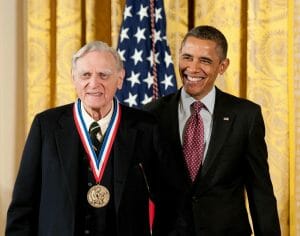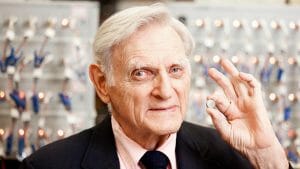Born in Germany to American parents, Goodenough grew up in an educated family: his father was a professor in the history of religion at Yale; his brother Ward Goodenough was an anthropologist at the University of Pennsylvania; his half-sister Ursula Goodenough is an emeritus professor of biology at Washington University in St. Louis; and half-brother Daniel A. Goodenough is an emeritus professor of biology at Harvard Medical School. Before serving as a U.S. Army Air Corps weatherman in World War II, Goodenough earned a degree in mathematics (summa cum laude) from Yale. After reading Science and the Modern World by Alfred North Whitehead at the conclusion of his time at Yale, “it seemed to me that much of the intellectual ferment of my generation would be in science; and physics provides a fundamental foundation for science. If there was to be an opportunity to go to graduate school after the war, I felt that night that I should study physics.” He rose to Captain in the Army, and was told he was selected to keep his rank and attend the University of Chicago school for a Master’s and Ph.D. in physics. He did this despite significant dyslexia. “I never was a good reader, and through my school years, I worked hard to cover my deficiency,” he said years later. “I also had a deep sense of insecurity that only lifted slowly as I grew older.”

At Chicago, one of his professors was John Simpson, who was a group leader on the Manhattan Project. “When I went to register, Professor Simpson said to me, ‘I don’t understand you veterans. Don’t you know that anyone who has ever done anything significant in physics had already done it by the time he was your age; and you want to begin?!’” He went anyway, and after graduating he spent 24 years as a research scientist and team leader at MIT’s Lincoln Laboratory, where he was to use a computer for his work. “In 1952, the digital computer ran on vacuum tubes and filled the space of a large dance hall; but it had no memory,” he said. MIT’s Jay Forrester had invented random-access memory — RAM — but its inability to switch the magnetization direction fast enough hindered operations. Goodenough was assigned to a team to fix that, and he made fundamental discoveries to make it possible. Apparently there were still significant things to be done with physics. Jay Forrester called the team into office to ask, “Now that you have worked yourselves out of a job, what are you planning to do?”
“I came up with the idea of a magnetic-film memory in which all the individual atomic moments would switch simultaneously rather than sequentially. On paper it promised to increase the switching speed one-thousand-fold. However, magnetic cores could be made smaller and realization of reliable switching of films meant slowing of their switching time. Since the film technology was more demanding, the eventual difference in switching speeds was not great enough for a move to magnetic films except for a few niche operations. With the advent of fast transistors that could be miniaturized, the Whirlwind Digital Computer and its magnetic memory became obsolete, but this technology was a critical step in the evolution to today’s supercomputers and laptops.” And Goodenough was far from being out of ideas.
”At Lincoln Laboratory in 1970, I turned my attention to the problem of renewable energy and energy conservation. It was obvious already in 1970 that our dependence on foreign oil was making the country as vulnerable as the threat of ballistic missiles from Russia.” But, he continued, “we were told that we were an Air Force laboratory, and that energy was to be the domain of the National Energy Laboratories and of Industry. Politics, not potential productivity, is the bull in the china shop of science administration. It was a discouraging moment, and I realized it was time for me to leave Lincoln Laboratory.”

Goodenough moved to the University of Oxford to head the Inorganic Chemistry Lab, where he perfected the chemistry of lithium-ion batteries, allowing enough power to be delivered by small, lightweight batteries to lead to revolutions in electronics, such as smartphones and laptop computers. Did he get rich? He was working with “AERE Laboratory in Harwell, a town near Oxford,” whose lawyers “would not proceed unless we signed all our rights away. Not knowing either the full potential of our invention or any other option, we signed our rights away.” Sony used their lithium-ion batteries to power the first cell phone. “AERE Harwell received many millions of pounds; we received nothing,” he said. “However, the joy of having helped to enable a technology that has transformed for the better so many lives is reward enough.”
In 1986, he returned to the U.S. to teach and research at the University of Texas at Austin, where he worked in Mechanical, as well as Electrical and Computer, Engineering. His research especially focused on improving batteries for electric vehicles, getting back to not just reducing our dependence on foreign oil, but “We have to, in the near future, make a transition from our dependence on fossil fuels to a dependence on clean energy,” he said. “So that’s what I’m currently trying to do before I die.” And, he added, “I think we’re on the cusp of being able to do it.” He continued work at the university for 32 years, when he was 98 years old.

Goodenough was a co-recipient of the 2009 Enrico Fermi Award for his work in lithium-ion batteries; while in graduate school, Goodenough worked with Fermi himself. He was awarded the National Medal of Science by President Barack Obama in 2013, and in 2019 received the Nobel Prize in Chemistry for his work on lithium-ion batteries — making him the oldest-ever recipient of a Nobel Prize. “John’s legacy as a brilliant scientist is immeasurable,” declared UT Austin President Jay Hartzell. “His discoveries improved the lives of billions of people around the world.” For Goodenough’s 100th birthday, scientists and engineers specializing in batteries came from all over the world to celebrate him. John Bannister Goodenough died June 25 in an assisted living facility in Austin, Texas. He was 100 — exactly one month shy of 101.
